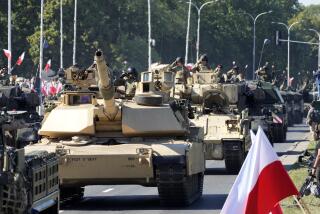How Much Defense Is Enough? : It’s a time of rethinking--and uncertainty--for U.S. planners
- Share via
American military spending, reports the International Institute of Strategic Studies, is more than three times greater than any other country’s and in fact exceeds the outlays of all of this nation’s potential enemies combined. No country has troops that are better trained, and none can match the quality of U.S. military equipment. Yet many thoughtful observers--a category not always synonymous with members of Congress--question whether national security needs are truly being met, even with annual military budgets of about $260 billion.
More than four decades of Cold War defense plans and policies--and thus defense budgets--were essentially shaped by estimates of what the Soviet Union was up to. The post-Cold War era, with its less apocalyptic but more diffuse security challenges, vastly complicates defense planning. A coherent strategy for the new era, based on a clear sense of what military missions U.S. forces should be prepared for, has yet to emerge.
Defense spending has been falling for the last decade. As a share of the federal budget--it’s now about 17%--or of the gross domestic product, military outlays are lower today than at any time in generations. Some in Congress view this shrinkage with alarm and call for bigger Pentagon budgets, though without being very specific about why additional money is needed. Spending more just to be spending more does nothing to define defense strategy. As Lawrence J. Korb of the Brookings Institution notes in a recent issue of Foreign Affairs, “defense spending should be measured against the efforts of potential adversaries and allies, not past U.S. administrations.” Using that common-sense standard, a $260-billion military budget seems more than adequate when compared with Russia’s, about $80 billion, or China’s, under $30 billion, or what the recognized rogue states--Iran, Iraq, Libya, Syria, North Korea and Cuba--spend in total, about $15 billion.
Just after the Clinton administration took office, the Defense Department conducted what it called a bottoms-up review of U.S. military needs in the post-Cold War world. It concluded the nation should retain the capability to fight and win two major regional wars virtually simultaneously, the expected locations being Southwest Asia--on or around the Arabian Peninsula--and Korea. From that assessment came a projection of needs: a total force of 2.5 million, with 1 million being reservists; 12 carrier battle groups, numbering 346 ships; 20 air wings, 184 strategic bombers, 3,500 nuclear warheads. Whether the assumptions on which these conclusions were based remain valid has become increasingly debatable.
As Times correspondent Art Pine pointed out in a recent series, the structure of the U.S. armed forces has changed little since the end of the Cold War, though both the nature of the security threat and the means for confronting it have altered dramatically. New military technology that has expanded the range and accuracy of weapons and the effectiveness of support equipment might well reduce the need both for fighting troops, support units and weapons delivery systems. Vastly improved intelligence and communications capabilities could require both strategic doctrine and battlefield tactics to be rewritten.
A new and rigorous full-scale review of military missions and capabilities clearly ought to be high on the agenda of the president who takes the oath of office next Jan. 20. The primary concern isn’t so much how many dollars for defense there should be. It’s how defense dollars should be spent and how planning should be revised in the light of changing geopolitical challenges and rapid technological evolution.
More to Read
Sign up for Essential California
The most important California stories and recommendations in your inbox every morning.
You may occasionally receive promotional content from the Los Angeles Times.













